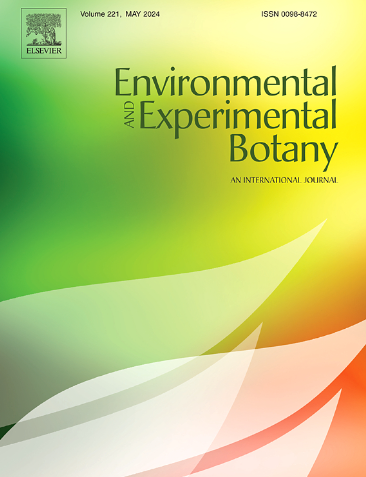The development of biological soil crusts reshapes the strategies of non-structural carbohydrates in response to nitrogen deposition
IF 4.7
2区 生物学
Q2 ENVIRONMENTAL SCIENCES
引用次数: 0
Abstract
Non-structural carbohydrates (NSC) are critical indicators of the carbon acquisition and consumption balance in vascular plants, and are equally important for biological soil crusts (BSCs), which serve as significant carbon sinks in arid regions. Nitrogen (N) deposition significantly alters NSC storage by affecting plant growth, photosynthesis, and the carbon-to-nitrogen ratio. However, the response of NSC to N deposition may vary across different developmental stages of BSCs due to differences in physiological structures and soil properties. We conducted a long-term field N addition experiment (2010–2021) in the Gurbantunggut Desert, with N rates from 0 to 3 g m⁻² yr⁻¹ and a 2:1 NH₄⁺-N to NO₃⁻-N ratio, to examine the effects of N on NSC and their components (fructose, sucrose, soluble sugars, and starch) in three BSC types: cyanobacterial, lichen, and moss crusts. Our results revealed that the development of BSCs from cyanobacterial to lichen and moss crusts significantly alters NSC allocation, with an increasing ratio of soluble sugars to starch (0.24–1–1.68). As N added levels rise, NSC content in all three BSC types exhibits a nonlinear trend, characterized by low promotion and high inhibition, with distinct threshold points (N1.5-N0.5-N0.5). This phenomenon arises from shifts in the NSC driving factors under N addition: transitioning from soil nutrient dependence (cyanobacteria) to regulation by plant antioxidant enzyme activity (lichen), and ultimately to a more complex physiological regulation involving photosynthetic pigments and antioxidant enzyme activities (Moss). This study reveals the transition of BSCs from “environmental adapters” to “ecological regulators” throughout their successional stages. These findings provide new insights into the C metabolism of BSCs and have important implications for ecological restoration in N-impacted arid regions.
生物结皮的发育重塑了非结构性碳水化合物对氮沉降的响应策略
非结构性碳水化合物(Non-structural carbohydrate, NSC)是维管植物碳获取和消耗平衡的重要指标,对干旱地区具有重要碳汇作用的生物土壤结皮也同样重要。氮沉降通过影响植物生长、光合作用和碳氮比显著改变NSC储存。然而,由于生理结构和土壤性质的差异,NSC对N沉降的响应可能在BSCs的不同发育阶段有所不同。我们在古尔班通古特沙漠进行了一项长期的田间N添加实验(2010-2021),N率为0到3 g m⁻²yr⁻¹ ,NH₄+ -N与NO₃⁻-N的比例为2:1,以研究N对蓝藻、地衣和苔藓三种BSC类型中NSC及其成分(果糖、蔗糖、可溶性糖和淀粉)的影响。研究结果表明,蓝藻细胞向地衣和苔藓结壳的发育显著改变了NSC的分配,可溶性糖与淀粉的比例增加(0.24-1-1.68)。随着N添加水平的升高,三种平衡记分卡中NSC含量均呈现出低促进、高抑制的非线性趋势,且具有不同的阈值点(n1.5 ~ n0.5 ~ n0.5)。这一现象的产生是由于氮素添加下NSC驱动因子的转变:从土壤养分依赖(蓝藻)到植物抗氧化酶活性的调节(地衣),最终到涉及光合色素和抗氧化酶活性的更复杂的生理调节(苔藓)。本研究揭示了生物干细胞在演替过程中从“环境适应者”向“生态调节者”的转变。这些发现为BSCs的C代谢提供了新的认识,并对氮影响干旱区的生态恢复具有重要意义。
本文章由计算机程序翻译,如有差异,请以英文原文为准。
求助全文
约1分钟内获得全文
求助全文
来源期刊

Environmental and Experimental Botany
环境科学-环境科学
CiteScore
9.30
自引率
5.30%
发文量
342
审稿时长
26 days
期刊介绍:
Environmental and Experimental Botany (EEB) publishes research papers on the physical, chemical, biological, molecular mechanisms and processes involved in the responses of plants to their environment.
In addition to research papers, the journal includes review articles. Submission is in agreement with the Editors-in-Chief.
The Journal also publishes special issues which are built by invited guest editors and are related to the main themes of EEB.
The areas covered by the Journal include:
(1) Responses of plants to heavy metals and pollutants
(2) Plant/water interactions (salinity, drought, flooding)
(3) Responses of plants to radiations ranging from UV-B to infrared
(4) Plant/atmosphere relations (ozone, CO2 , temperature)
(5) Global change impacts on plant ecophysiology
(6) Biotic interactions involving environmental factors.
 求助内容:
求助内容: 应助结果提醒方式:
应助结果提醒方式:


